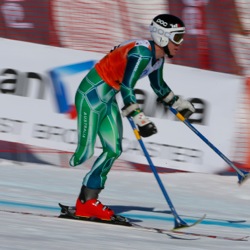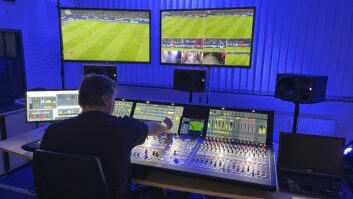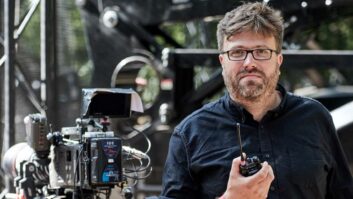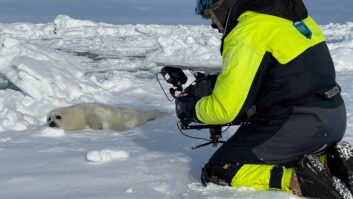
Seven years ago, the Black Sea resort of Sochi in the Russian Federation was chosen as the venue for the 2014 Winter Olympics and Paralympics. Although this is the first occasion a location in Russia has been selected to host these games, the name of Sochi is set to become quite familiar. As well as the forthcoming Olympics, the city will be the site of the Russian Formula 1 Grand Prix from 2014 until at least 2020, and it is one of the host cities for the 2018 FIFA World Cup.
To prepare for the extensive television coverage demanded by these events, ANO Sports Broadcasting (now better known as Panorama) was established in 2009 as an autonomous non-profit organisation by Russia’s Channel One, VGTRK, NTV-PLUS and the RIA Novosti news agency. It will provide the national signal for the Olympics (OBS provides the international feed) and international signal for the Paralympics.
One of Panorama’s first moves was to order 12 outside broadcast units from Sony. Complementing these OB units was a Mobile Master Control Room to integrate the output from the vans and other sources, and combine them into one production unit.
Test runs
Using that impressive inventory of vehicles, the company has been involved in numerous projects in preparation for the upcoming games. For example, it acted as host broadcaster for 17 Olympic test events in the 2011-2013 winter seasons that took place in Sochi. These included the Figure Skating Grand Prix at the Iceberg Winter Sports Palace and the Ski Jumping World Cup. Both events were transmitted to a worldwide audience.
“The Iceberg Palace of Winter Sports was the first commissioned Olympic facility,” explains Sergey Revin, Panorama’s CTO (pictured). “The camera work here was also something new for the creative and production team of Panorama. Alongside the conventional cameras, we utilised a Robycam system to enhance the coverage for the rights holding broadcasters.”
Robycam, which was developed in Moscow by Movicom, is one of few aerial cable systems which provides the ability to move the Sony HDC-P1 camera fitted with a Fujinon HA14x4.5BERD wide angle lens in almost any direction in 3D. The technology involves using a specially developed mathematical model that serves as a base for realtime control of four automated winches. The system incorporates advanced gyro-stabilisation and motion control techniques.
“This equipment allowed us to show some unusual, and extremely spectacular, angles of the skaters on the ice,” adds Revin with some enthusiasm. He goes on, “For the Ski Jumping World Cup we used both a 10-camera and a 16-camera HD OB to ensure the most comprehensive coverage of this important event.”
Training the staff
Many of the personnel manning the production units have come from the extensive training programme that Panorama HD established about three years ago. “We selected and trained over 1200 persons from all over Russia in our own multi-stage programme. This was unprecedented in scale for modern Russia – for both resident training and e-learning in 27 specialties. The residential course took place in Moscow, partly at the Skolkovo School of Management.”
Revin reports that the best Russian and foreign TV production professionals shared their experience with the students. During the breaks between the two full-time courses the programme participants underwent e-learning. Having successfully completed the course, the participants received state-recognised advanced training certificates.
As part of that training programme, the company developed a mobile application featuring an English-Russian/Russia-English broadcasting glossary comprising 16,000 word combinations.
Learning the lessons
Another part of the preparation for Sochi involved a team from Panorama visiting Ruhpolding, Germany to view how the host broadcaster, Bayerischer Rundfunk, covered the Biathlon World Cup. “Our colleagues from Germany were very helpful by allowing us to watch the entire set-up process right from unreeling the cables to viewing the production from the OB vans.”
The lessons learned were put into practice in March 2013 when the following Biathlon World Cup took place at the Laura Cross-country Ski and Biathlon Centre to the north-east of Sochi. Panorama again was working as the host broadcaster, providing the international HD signal of the event. However, not everything ran according to plan for the overall coverage.
Due to the ongoing road works in the area, the OB units could not get to the Centre and had to be parked about 8km away from the competition tracks. To enable TV production to go ahead, the signals from all camera positions located along the 10km race tracks were transferred via dark fibre lines to the Technical Operations Centre at the broadcast compound in Laura – and then on to the OB truck. From here the cameras on the track were operated remotely through Telecast systems. The Panorama team was using the fibre lines already installed for the cross country events in February. “The whole operation was a tremendous success, despite the problems surrounding the site,” reports Revin.
Software solution
One significant solution that Panorama has installed atSochi is its Media Office system. This is a versatile platform that allows ingesting, editing, logging, storing, searching, and delivering digital content to multiple users in realtime.
Feeds coming from any source – OB or DSNG vans, or ENG crews – are captured and stored in a single archive. Utilising EVS’s IP Web-browser technology, the Office enables fast search and retrieval of relevant video content from anywhere in the world.
“This is an innovative tool that allows up to 100 users working on news bulletins or feature stories to simultaneously search for and work with video. It is based on the Octopus6 Newsroom System, and allows users to piece together videos, images and text into a rundown. It also allows fast edits of video content, such as highlights, summaries, interviews, packages and so on, and delivery upon user request, including to OB vans operating at live events. This will be invaluable at Sochi.”
He concludes, “We anticipate that the Winter Olympic Games will attract somewhere in the region of 3.5 billion viewers worldwide. The intensive preparation work that we have undergone at Panorama will enable us to set a new standard in the coverage of such high profile events.”
By Philip Stevens
www.panoramahd.ru
www.robycam.ru
www.octopus-news.com
www.sony.co.uk
www.egripment.com







